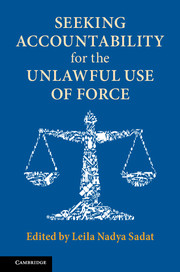Book contents
- Frontmatter
- Dedication
- Contents
- Notes on Contributors
- Foreword
- Preface
- Table of Cases
- Introduction
- PART I HISTORIC AND CONTEMPORARY PERSPECTIVES ON THE UNLAWFUL USE OF FORCE
- PART II MECHANISMS FOR RESTRAINING THE UNLAWFUL USE OF FORCE AND ENHANCING ACCOUNTABILITY
- PART III THE ILLEGAL USE OF FORCE AND THE PROSECUTION OF INTERNATIONAL CRIMES
- PART IV IMAGINING A BETTER WORLD
- 17 Rethinking the Relationship Between Jus in Bello and Jus ad Bellum: A Dialogue Between Authors
- 18 Twenty-First Century Paradigms on Military Force for Humane Purposes
- 19 The Presumption of Peace: Illegal War, Human Rights, and Humanitarian Law
- 20 The Urgent Imperative of Peace
- Epilogue
- Index
17 - Rethinking the Relationship Between Jus in Bello and Jus ad Bellum: A Dialogue Between Authors
from PART IV - IMAGINING A BETTER WORLD
Published online by Cambridge University Press: 21 May 2018
- Frontmatter
- Dedication
- Contents
- Notes on Contributors
- Foreword
- Preface
- Table of Cases
- Introduction
- PART I HISTORIC AND CONTEMPORARY PERSPECTIVES ON THE UNLAWFUL USE OF FORCE
- PART II MECHANISMS FOR RESTRAINING THE UNLAWFUL USE OF FORCE AND ENHANCING ACCOUNTABILITY
- PART III THE ILLEGAL USE OF FORCE AND THE PROSECUTION OF INTERNATIONAL CRIMES
- PART IV IMAGINING A BETTER WORLD
- 17 Rethinking the Relationship Between Jus in Bello and Jus ad Bellum: A Dialogue Between Authors
- 18 Twenty-First Century Paradigms on Military Force for Humane Purposes
- 19 The Presumption of Peace: Illegal War, Human Rights, and Humanitarian Law
- 20 The Urgent Imperative of Peace
- Epilogue
- Index
Summary
INTRODUCTION
The question of the relationship between the two bodies of law regulating the use of deadly force in armed conflict is complex, diversified, and highly relevant to the realities of modern warfare. Increasingly, in fact, the lawfulness or even legitimacy of a war or other recourse to deadly force is invoked as a yardstick to determine the level of compliance with the laws of armed conflict. Claims that enemy combatants’ lack of observance of religious percepts justifies gratuitous brutality toward them and the civilian populations under their control, unless they prove themselves worthy of compassion by forcefully converting to a distorted and offensive version of Islam, pervades the rhetoric and war ethos of ISIS fighters. Similarly, violations of the laws of war, justified by considerations of state survival on one hand, and self-determination or military necessity on the other, are a daily occurrence in many international and non-international armed conflicts. In the wake of the September 11th attacks, the United States advanced an alternative legal architecture to justify its treatment of detainees and its conduct of hostilities in the so-called “Global War on Terror.” Most recently, the reform of peacekeeping and the increase in mandates for the protection of civilians and atrocity prevention has raised the question of whether current rules of engagement should be revisited to accommodate the fundamentally different nature of these military operations. Moreover, recent scholarship has questioned whether in the case of a war of aggression, proportionality and military necessity can ever be rightfully invoked by the aggressor, positing that force used in contravention of modern jus contra bellum is in itself a violation of the law of armed conflict. These positions, which sometimes inject ad bellum considerations into in bello discussions and vice versa, pose important theoretical and epistemic challenges to the discipline of jus belli. Moreover, these challenges have important consequences both in the battlefield (as the experience of combatants and civilians whose protection under humanitarian law has been arbitrarily removed attests), as well as in its aftermath.
- Type
- Chapter
- Information
- Seeking Accountability for the Unlawful Use of Force , pp. 453 - 492Publisher: Cambridge University PressPrint publication year: 2018

